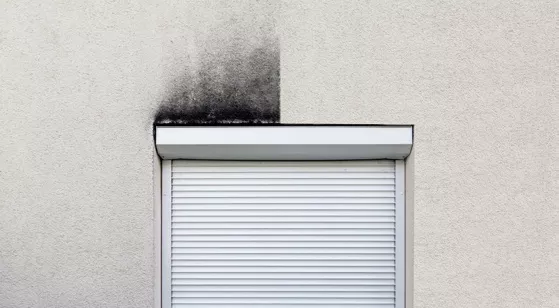Causes of Algae Growth on Facades
Algae infestation on building facades usually results from a combination of local conditions and building physics.
The Most Common Causes
High Humidity
In regions with frequent rainfall, fog, or proximity to bodies of water, the air remains constantly humid – ideal conditions for algae growth.
Lack of Sunlight
North-facing facades or those shaded by trees and neighboring buildings dry more slowly and stay damp for longer.
Surface Structure and Material
Rough plaster, mineral surfaces, or porous building materials retain water longer than smooth surfaces, thus promoting algae formation.
Environmental Influences
Dense vegetation, overhanging branches, or tightly built areas increase moisture on the facade.
Dirt and Dust Deposits
Dust particles and other deposits provide algae with an ideal breeding ground to spread quickly.

Building Physics – Impact on Algae Growth
A key factor for strong algae growth on facades is dew formation. Modern, increasingly efficient thermal insulation causes facade surfaces to cool down more at night.
As a result, more dew forms, serving as an additional source of moisture. This persistent dampness creates perfect conditions for algae to settle and spread across the facade.
Ventilation Habits – Influence on Algae Formation
If a window remains permanently tilted, warm indoor air continuously flows upward along the facade.
This leads to the formation of condensation above the window.
The constant moisture encourages algae to settle and spread particularly quickly in these areas.
Shading – A Factor in Algae Growth
Trees, shrubs, flower pots, or decorative objects can cast shadows that prevent the facade from drying completely in certain areas.
Particularly affected is the so-called weather side of a building. With little direct sunlight, hardly any warmth develops, leaving the surface damp for longer – again, ideal conditions for algae growth.
Additional Factors That Influence Algae Growth
Besides the causes already mentioned, there are several other influences that can promote algae growth on facades, including:
✓ Air quality – Fine dust and air pollution provide additional nutrients.
✓ Surface type – Smooth surfaces dry faster, rough surfaces retain moisture longer.
✓ Average annual temperature – Mild climates encourage growth throughout the year.
✓ Spore distribution – Algae spores spread through wind, rain, and other weather conditions.
These factors often act together, significantly accelerating the formation and spread of algae.
